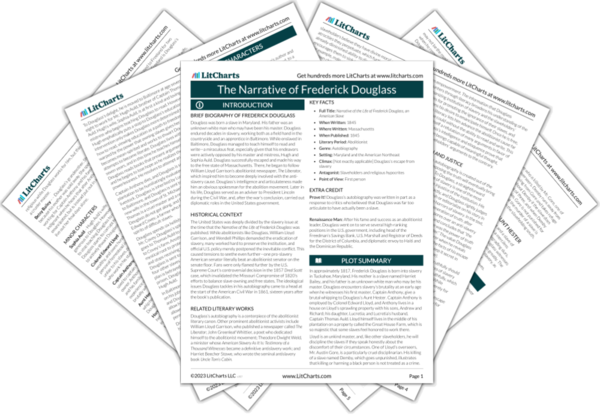Welcome to the LitCharts study guide on Frederick Douglass's The Narrative of Frederick Douglass. Created by the original team behind SparkNotes, LitCharts are the world's best literature guides.
Narrative of Frederick...: Introduction
A concise biography of Frederick Douglass plus historical and literary context for The Narrative of Frederick Douglass.
Narrative of Frederick...: Plot Summary
A quick-reference summary: The Narrative of Frederick Douglass on a single page.
Narrative of Frederick...: Detailed Summary & Analysis
In-depth summary and analysis of every chapter of The Narrative of Frederick Douglass. Visual theme-tracking, too.
Narrative of Frederick...: Themes
Explanations, analysis, and visualizations of The Narrative of Frederick Douglass's themes.
Narrative of Frederick...: Quotes
The Narrative of Frederick Douglass's important quotes, sortable by theme, character, or chapter.
Narrative of Frederick...: Characters
Description, analysis, and timelines for The Narrative of Frederick Douglass's characters.
Narrative of Frederick...: Symbols
Explanations of The Narrative of Frederick Douglass's symbols, and tracking of where they appear.
Narrative of Frederick...: Literary Devices
The Narrative of Frederick Douglass's key literary devices explained and sortable by chapter.
Narrative of Frederick...: Quizzes
Detailed quizzes covering every chapter of The Narrative of Frederick Douglass
Narrative of Frederick...: Theme Wheel
An interactive data visualization of The Narrative of Frederick Douglass's plot and themes.
Brief Biography of Frederick Douglass
Douglass was born a slave in Maryland. His father was an unknown white man who may have been his master. Douglass endured decades in slavery, working both as a field hand in the countryside and an apprentice in Baltimore. While enslaved in Baltimore, Douglass managed to teach himself to read and write—a miraculous feat, especially given that his endeavors were actively opposed by his master and mistress, Hugh and Sophia Auld. Douglass successfully escaped and made his way to the free state of Massachusetts. There, he began to follow William Lloyd Garrison’s abolitionist newspaper, The Liberator, which inspired him to become deeply involved with the anti-slavery cause. Douglass’s intelligence and articulateness made him an obvious spokesman for the abolition movement. Later in his life, Douglass served as an adviser to President Lincoln during the Civil War, and, after the war’s conclusion, carried out diplomatic roles in the United States government.
Get the entire Narrative of Frederick... LitChart as a printable PDF.

Historical Context of The Narrative of Frederick Douglass
The United States was deeply divided by the slavery issue at the time that the Narrative of the Life of Frederick Douglass was published. While abolitionists like Douglass, William Lloyd Garrison, and Wendell Phillips demanded the eradication of slavery, many worked hard to preserve the institution, and official U.S. policy merely postponed the inevitable conflict. This caused tensions to seethe even further—one pro-slavery American senator literally beat an abolitionist senator on the senate floor. Fans were only flamed further by the U.S. Supreme Court’s controversial decision in the 1857 Dred Scott case, which invalidated the Missouri Compromise of 1820’s efforts to balance slave-owning and free states. The ideological issues Douglass tackles in his autobiography came to a head at the start of the American Civil War in 1861, sixteen years after the book’s publication.
Other Books Related to The Narrative of Frederick Douglass
Douglass’s autobiography is a centerpiece of the abolitionist literary canon. Other prominent abolitionist activists include William Lloyd Garrison, who published a newspaper called The Liberator; John Greenleaf Whittier, a poet who dedicated himself to the abolitionist movement; Theodore Dwight Weld, a minister whose American Slavery As It Is: Testimony of a Thousand Witnesses became a definitive antislavery work; and Harriet Beecher Stowe, who wrote the seminal antislavery book Uncle Tom’s Cabin.
Key Facts about The Narrative of Frederick Douglass
- Full Title: Narrative of the Life of Frederick Douglass, an American Slave
- When Written: 1845
- Where Written: Massachusetts
- When Published: 1845
- Literary Period: Abolitionist
- Genre: Autobiography
- Setting: Maryland and the American Northeast
- Climax: [Not exactly applicable] Douglass’s escape from slavery
- Antagonist: Slaveholders and religious hypocrites
- Point of View: First person
Extra Credit for The Narrative of Frederick Douglass
Prove It! Douglass’s autobiography was written in part as a response to critics who believed that Douglass was far too articulate to have actually been a slave.
Renaissance Man: After his fame and success as an abolitionist leader, Douglass went on to serve several high-ranking positions in the U.S. government, including head of the Freedman’s Savings Bank, U.S. Marshall and Registrar of Deeds for the District of Columbia, and diplomatic envoy to Haiti and the Dominican Republic.












